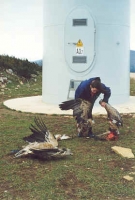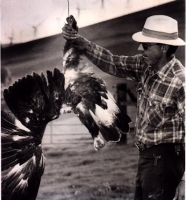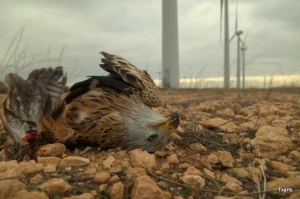
America’s wind farms are actually slaughtering millions of birds and bats annually
By Mark Duchamp, Save the Eagles International and World Council for Nature
Originally published at http://www.theecoreport.com/
April 26, 2014 (San Diego)--The Obama administration is issuing 30-year permits for “taking” (killing) bald and golden eagles. The great birds will be legally slaughtered “unintentionally” by lethal wind turbines installed in their breeding territories, and in "dispersion areas" where their young congregate (e.g. Altamont Pass).
By chance (if you believe in coincidences), a timely government study claims wind farms will kill “only” 1.4 million birds yearly by 2030. This new report is just one of many, financed with taxpayers' money, aimed at convincing the public that additional mortality caused by wind plants is sustainable. - It is not.
Dr. Shawn Smallwood’s 2004 study, spanning four years, estimated that California’s Altamont Pass wind "farm" killed an average of 116 Golden Eagles annually. This adds up to 2,900 dead “goldies” since it was built 25 years ago. Altamont is the biggest sinkhole for the species, but not the only one, and industry-financed research claiming that California's GE population is stable is but a white-wash.
Eagles are not the only victims. Smallwood also estimated that Altamont killed an average of 300 red-tailed hawks, 333 American kestrels and 380 burrowing owls annually – plus even more non-raptors, including 2,526 rock doves and 2,557 western meadowlarks.
In 2012, breaking the European omerta on wind farm mortality, the Spanish Ornithological Society (SEO/Birdlife) reviewed actual carcass counts from 136 monitoring studies. They concluded that Spain’s 18,000 wind turbines are killing 6-18 million birds and bats yearly.
Extrapolating that and similar (little publicized) German and Swedish studies, 39,000 U.S. wind turbines would not be killing “only” 440,000 birds (USFWS, 2009) or “just” 573,000 birds and 888,000 bats (Smallwood, 2013), but 13-39 million birds and bats every year!
However, this carnage is being covered up by self-serving and/or politically motivated government agencies, wind industry lobbyists, environmental groups and ornithologists, under a pile of misleading studies paid for with more taxpayer money.
Wildlife expert Jim Wiegand has documented how areas searched under wind turbines are still confined to 200-foot radiuses, even though modern monster turbines catapult 90% of bird and bat carcasses much further. Windfarm owners, operating under voluntary(!) USFWS guidelines, commission studies that search much-too-small areas, look only once every 30-90 days, ensuring that scavengers remove most carcasses, and ignore wounded birds that happen to be found within search perimeters. (Details at MasterResource.org)
These research protocols are designed to guarantee extremely low mortality statistics, hiding the true death tolls – and the USFWS seems inclined to let the deception continue. In addition, bird mortality data are now considered to be the property of windfarm owners, which means the public no longer has a right to know.
Nevertheless, news has leaked that eagles are being hacked to death all across America. This is hardly surprising, as raptors are attracted to wind turbines. They perch on them to rest or scan for prey. They come because turbines are often built in habitats that have abundant food (live or carrion) and good winds for gliding.
 Save the Eagles International (STEI) has posted photographs of raptors perched on nacelles or nonmoving blades, and ospreys building a nest on a decommissioned turbine. Moving blades don’t deter them either: videos show a turkey vulture perched on the hub of a spinning turbine, and a griffon vulture being struck. Birds perceive areas traveled by spinning blades as open space, unaware that blade tips are moving at up to 180 mph. Many are focused on prey. These factors make wind turbines “ecological death traps,” wherever they are located.
Save the Eagles International (STEI) has posted photographs of raptors perched on nacelles or nonmoving blades, and ospreys building a nest on a decommissioned turbine. Moving blades don’t deter them either: videos show a turkey vulture perched on the hub of a spinning turbine, and a griffon vulture being struck. Birds perceive areas traveled by spinning blades as open space, unaware that blade tips are moving at up to 180 mph. Many are focused on prey. These factors make wind turbines “ecological death traps,” wherever they are located.
By 2030, the United States plans to produce 20% of its electricity from wind. That’s nearly six times as much as today, from three or four times as many turbines, striking more flying creatures due to their bigger size (even the mendacious study predicting 1.4 million bird kills recognizes this). Using the higher but still underestimated level of mortality published by Smallwood in 2013, by 2030 our wind turbines would be killing over 3 million birds and 5 million bats annually.
But this is shy of reality by a factor of ten, because 90% of casualties land outside the search perimeter and are not counted. We are thus really talking about an unsustainable death toll of 30 million birds and 50 million bats a year – and more still if we factor in other hide-the-mortality tricks documented by STEI.
This carnage includes protected species that cars and cats rarely kill: eagles, hawks, falcons, owls, condors, whooping cranes, geese, bats and many others. The raptor slaughter will cause rodent populations to soar. Butchery of bats, already being decimated by White Nose Syndrome, will hammer agriculture.
The U.S. Geological Survey says the value of pest-control services to US agriculture provided by bats ranges from $3.7 billion to as much as $53 billion yearly. These chiropters also control forest pests and serve as pollinators. A Swedish study documents their attraction from as far as nine miles away to insects that swarm around wind turbines. Hence the slaughter.
Wind lobbyists claim they need “regulatory certainty.” However, eagle “take” permits will also ensure extinction certainty – and ecological, agricultural, economic and social disasters that America cannot afford.
Mark Duchamp is president of Save the Eagles International, a nonprofit conservation organization: www.
Mark Duchamp
WCFN
Plaza de la Fuente
19313 Peralejos, Spain
Tel: 34 693 643 736
References:
- Mortality at Altamont Pass wind farm: Chapter 3, Page 73, Table 3-11: Species/Taxonomic group: Golden eagle – Mortality per year:
- adjusted for search detection: 75.6
- adjusted for search detection and scavenging: 116.5
- scroll down that last column to find the mortality for other species
Developing Methods to Reduce Bird Mortality in the Altamont Pass Wind Resource Area – Shawn Smallwood & Carl Thelander (2004) – for the California Energy Commission.
http://www.energy.ca.gov/
Full report page:
http://www.energy.ca.gov/pier/
- Pictures and videos of raptors attracted to wind farms: http://savetheeagles.
- Over 90% of mortality not accounted for - wildlife expert Jim Wiegand:
- search areas are too small: http://www.masterresource.org/
2013/03/wind-avian-mortality- ii/ - they miss 90% of the carcasses: http://www.masterresource.org/
2013/09/hiding-avian- mortality-altamont-pass/
- Spanish Ornithological Society: Spain’s wind turbines kill 6 to 18 million birds and bats yearly: http://
- 573,000 birds and 888,000 bats killed by wind turbines in the US annually (Smallwood, 2013): http://onlinelibrary.wiley.
- White Nose Syndrome: http://www.whitenosesyndrome.
- University of Colorado study: wind farms kill 600,000 to 900,000 bats yearly: http://abcnews.go.com/
- USGS: value of bats to agriculture: http://www.usgs.gov/newsroom/
- Two Swedish studies: "We recorded 11 species (of bats) ... flying over the ocean up to 14 km from the shore (to an offshore windfarm)." And: "… our data showing that at least 10 species, both migratory and resident, regularly forage far out at sea are novel." http://www2.ekol.slu.se/
"The bats did not avoid the turbines. On the contrary they stayed for shorter or longer periods hunting close to the windmills because of the accumulation of flying insects.... Bats also used wind turbines for resting." http://www.nat
The author's credentials:
President of Save the Eagles International and Chairman of the World Council for Nature, Mark Duchamp is a retired businessman with a passion for wildlife. Here are some of his achievements, based on 12 years dedicated to researching wind farms and related subjects:
The French Ornithological Society (LPO - Ligue pour la Protection des Oiseaux) invited him as a guest speaker, expenses paid, to an international symposium on the Red Kite (a European bird of prey facing extinction, in part due to wind farms). They published his contribution here, in English and French: http://rapaces.lpo.fr/sites/
His Op-Ed on global cooling was published by the Washington Times on Jan 30 2009, co-signed by Professor David Bellamy:
http://www.washingtontimes.
Clive Hambler (Lecturer in Biological and Human Sciences, Hertford College, University of Oxford), supports his work. They published a joint article here:
http://wcfn.org/2013/07/01/
Hambler quoted him in an article in The Spectator: "my colleague Mark Duchamp..."
http://www.spectator.co.uk/
He wrote a long email supporting Duchamp's work to a journalist in the US:
www.iberica2000.org/documents/
He refers to Duchamp in his book, "Conservation" (Cambridge University Press)
Duchamp founded Save the Eagles International and the World Council for Nature after a decade spent writing and publishing over 100 articles on wind farms on Iberica2000.org. Investigative media recognize him as an expert on the matter:
http://www.telegraph.co.uk/
http://www.dailymail.co.uk/
http://www.telegraph.co.uk/
http://www.express.co.uk/news/
http://www.canadafreepress.
http://www.eastcountymagazine.
http://www.masterresource.org/
In 2008 Duchamp co-founded the European Platform Against Windfarms, a federation grouping 645 associations from 24 countries. He administered it during five years as Executive Director.
His critiques of the ornithological establishment over the years produced a significant result: the Spanish Ornithological Society elected a new president in 2010, following which they started to tell the truth about mortality at wind facilities, and to challenge new wind projects in court. They obtained 136 wind farm monitoring reports from the government under freedom of information legislation. After studying them, they published a report in which they estimated that Spain's 18,000 wind turbines are actually killing 6 - 18 million birds and bats a year.







Comments
THE most cynical,